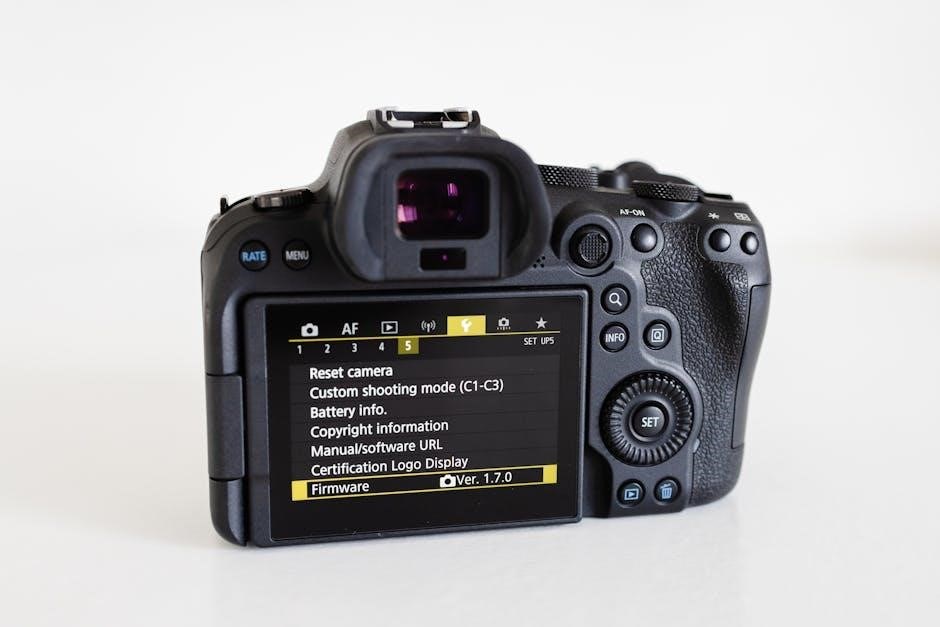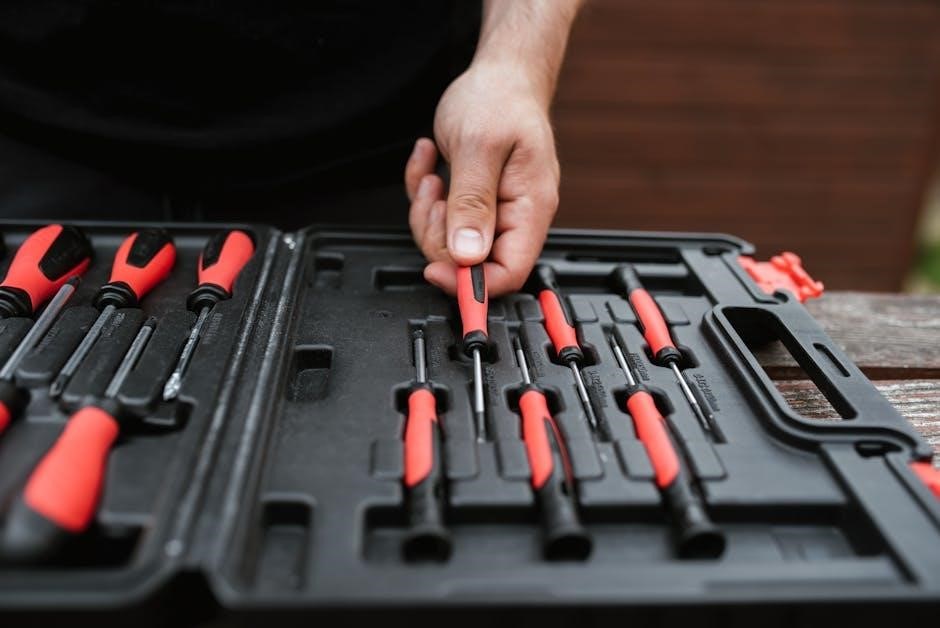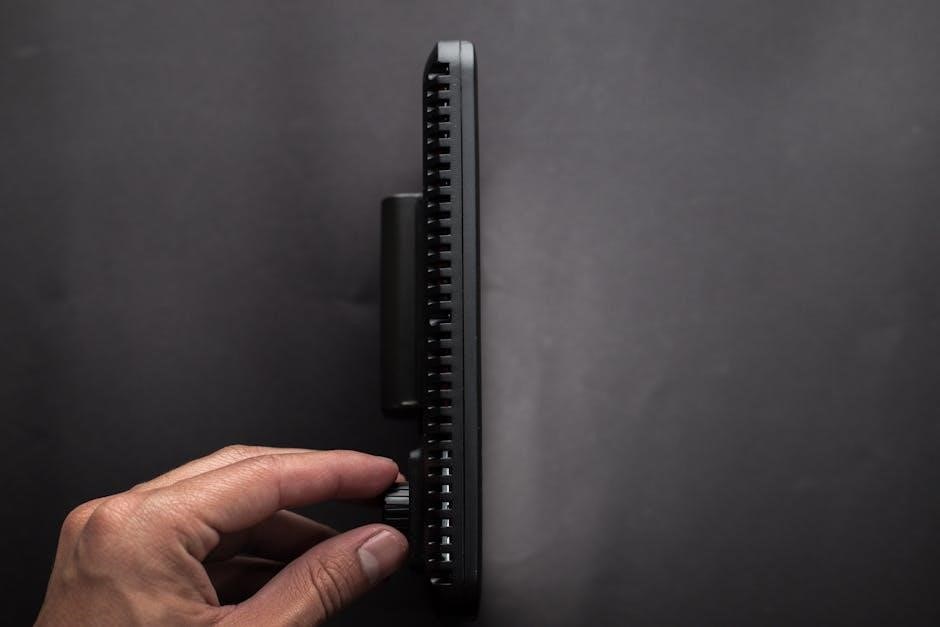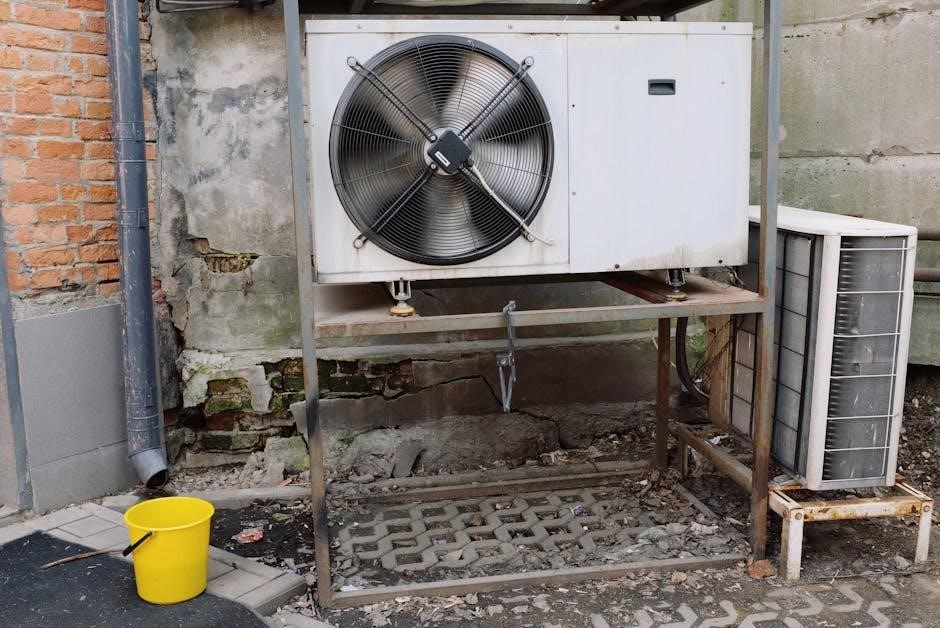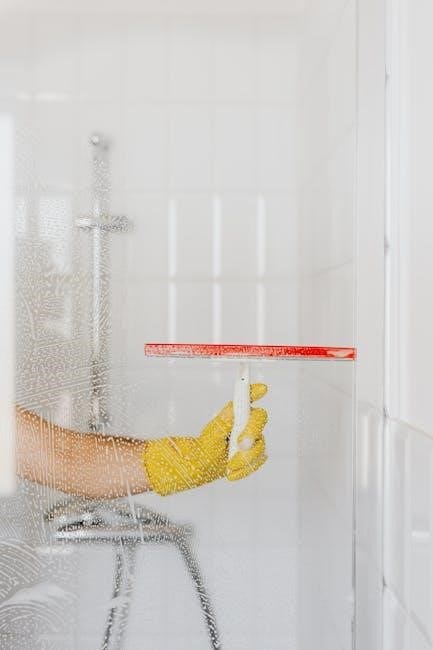The Safety 1st Thermometer is a reliable, user-friendly device designed for accurate temperature measurement․ It offers quick readings, multiple modes, and a fever indicator for added convenience and safety․
1․1 Overview of the Safety 1st Thermometer
The Safety 1st Thermometer is a versatile and reliable device designed for precise temperature measurement․ It offers quick and accurate readings, with multiple modes for oral, underarm, or rectal use․ Featuring a fever indicator and memory recall, it ensures convenience and ease of use; The thermometer is ideal for families, providing safe and efficient monitoring of health․ Its user-friendly design and durable construction make it a trusted choice for home use․
1․2 Importance of Thermometers for Home Use
Thermometers are essential for monitoring health at home, especially for children and infants; They provide quick and accurate readings, enabling timely medical decisions․ The Safety 1st Thermometer, with its multiple modes and fever indicator, offers convenience and reliability․ It empowers parents to track their child’s health effectively, ensuring peace of mind․ A reliable thermometer is a vital tool in every household, promoting early detection of fever and supporting overall well-being․ Regular use helps in maintaining health and safety for the whole family․
Key Features of the Safety 1st Thermometer
The Safety 1st Thermometer offers high accuracy, multiple modes (oral, underarm, rectal), quick readings, a fever indicator, and memory recall for previous readings, ensuring reliable performance․
2․1 High Accuracy and Reliability
The Safety 1st Thermometer ensures precise temperature readings with high accuracy, making it a trustworthy tool for monitoring health․ Its reliability is enhanced by consistent performance across multiple modes, providing accurate results whether used orally, under the arm, or rectally․ This consistency is crucial for parents seeking to monitor their child’s health effectively, ensuring peace of mind with every measurement․
2․2 Multiple Modes of Use (Oral, Underarm, Rectal)
The Safety 1st Thermometer offers versatility with its multiple modes of use, catering to different needs and preferences․ It can be used orally, under the arm, or rectally, providing flexibility for various situations․ This feature makes it ideal for families with children, as it accommodates different age groups and comfort levels․ The thermometer’s adaptability ensures accurate readings regardless of the method chosen, making it a practical choice for everyday use․ Its design prioritizes ease and comfort, enhancing the overall user experience․
2․3 Quick Reading and Fever Indicator
The Safety 1st Thermometer is designed for efficiency, providing quick and accurate temperature readings in just a few seconds․ It features a fever indicator that alerts users when a temperature exceeds normal levels, ensuring prompt attention․ This feature is particularly useful for parents monitoring their children’s health․ The clear display and audible beep signal when the reading is complete, making it easy to use even in busy or stressful situations․ This combination of speed and reliability makes it an essential tool for home health care․
2․4 Memory Recall for Previous Readings
The Safety 1st Thermometer includes a convenient memory recall feature, allowing users to track previous temperature readings․ This function is especially useful for monitoring trends in health, such as observing fluctuations in fever over time․ By storing past data, the thermometer helps parents and caregivers make informed decisions about care and treatment․ The memory feature ensures that important health information is readily accessible, making it a practical tool for managing family wellness effectively and efficiently․
Types of Safety 1st Thermometers
The Safety 1st Thermometer is available in four primary types: Forehead, Oral, Underarm, and Rectal, each designed for specific use cases and user preferences․
3․1 Forehead Thermometer
The Safety 1st Forehead Thermometer is a non-invasive and convenient option for measuring temperature․ It provides quick and accurate readings, ideal for infants and adults alike․ Designed for ease of use, it features a gentle scan function that ensures comfort․ The thermometer includes a fever indicator, which alerts users to elevated temperatures․ Operating instructions emphasize holding the device one inch from the forehead for precise results․ Regular cleaning with alcohol and proper storage are recommended to maintain accuracy and hygiene․ Supervision is advised when using it on young children․
3․2 Oral Thermometer
The Safety 1st Oral Thermometer is designed for accurate and comfortable temperature measurement․ It features a flexible tip for ease of use and a quick-read function that beeps when complete․ Suitable for all ages, it ensures precise readings in just seconds․ The thermometer includes memory recall for tracking previous measurements, adding convenience for users․ Cleaning with alcohol is recommended after each use to maintain hygiene․ Supervision is advised when using it on young children to ensure safe and proper operation․
3․3 Underarm Thermometer
The Safety 1st Underarm Thermometer offers a gentle and non-invasive way to measure temperature․ It features a flexible design for comfort and provides quick, accurate readings․ Suitable for all ages, it includes a fever indicator and memory recall for tracking previous measurements․ To ensure accuracy, the underarm area should be dry, and the arm held close to the body during measurement․ Cleaning with alcohol after use is recommended․ Supervision is advised when using it on young children to ensure proper use and safety․
3․4 Rectal Thermometer
The Safety 1st Rectal Thermometer is designed for infants and young children, offering precise temperature readings․ It features a flexible, rounded tip for comfort and safety․ The thermometer is easy to use and provides quick results, making it ideal for concerned parents․ It includes a fever indicator and memory recall for tracking previous readings․ Proper cleaning with alcohol after each use is essential․ Always follow the manual instructions for accurate measurements and safe usage․

How to Use the Safety 1st Thermometer
To use the Safety 1st Thermometer, ensure it’s prepared according to the manual․ Take measurements by following the mode-specific instructions․ Understand the display, including the fever indicator and memory recall features․ Always refer to the user guide for model-specific details․
4․1 Preparing the Thermometer for Use
Before using the Safety 1st Thermometer, read the manual carefully․ Ensure the device is powered with fresh batteries, properly seated to avoid errors․ Clean the probe with alcohol, allowing it to dry completely to maintain hygiene․ If using the forehead mode, ensure the thermometer is at room temperature for accurate readings․ For oral, underarm, or rectal use, prepare the area as instructed․ Always verify the thermometer is free from damage or wear․ Proper preparation ensures reliable and safe operation․
4․2 Taking Temperature Measurements
To take accurate readings, select the appropriate mode (oral, underarm, or rectal) based on the user’s age and preference․ For forehead use, position the thermometer one inch from the center of the forehead and press the scan button․ For oral or underarm modes, place the probe under the tongue or in the armpit, ensuring it remains still․ The device beeps once the reading is complete․ The fever indicator lights up if the temperature is elevated, providing quick and clear results for easy monitoring․ Always follow the manual for specific guidance․
4․3 Understanding the Display and Fever Bar
The Safety 1st Thermometer features a clear LCD display showing temperature readings in either Celsius or Fahrenheit․ The fever bar indicator lights up in segments, providing a visual cue for fever detection․ Each segment represents a temperature range, illuminating progressively as the reading increases․ Green indicates normal, while red signals a fever․ This intuitive system allows quick assessment without needing to interpret numbers, making it especially useful for parents monitoring their child’s health effectively and efficiently at home․

Safety Precautions and Guidelines
Ensure safe use by following all instructions․ Supervise children during use, as the thermometer is not a toy․ Clean the probe with alcohol after each use to maintain hygiene and accuracy․ Avoid using the device near flammable materials or in extreme temperatures․ Always replace batteries correctly to prevent damage․ Store the thermometer in its case when not in use to prevent accidental activation or damage․
5․1 Important Safety Instructions
Always supervise children when using the thermometer, as it is not a toy․ Ensure the device is used only for its intended purpose․ Clean the probe with alcohol after each use to maintain hygiene․ Avoid exposing the thermometer to extreme temperatures or flammable materials․ Replace batteries correctly to prevent damage․ Store the device in its protective case when not in use to avoid accidental activation․ Follow all instructions carefully to ensure accurate readings and safe operation․
5․2 Supervising Children During Use
Supervising children during thermometer use is crucial for their safety and the device’s proper functioning․ Ensure an adult handles the thermometer to avoid accidental damage or misuse․ Never let children treat it as a toy or play with it unsupervised․ Always store the thermometer in its protective case when not in use to prevent tampering․ Teach children the correct usage under adult guidance to foster understanding and responsibility while maintaining safety standards․
5․3 Cleaning and Maintenance Tips
To maintain the Safety 1st Thermometer’s accuracy and hygiene, clean the probe regularly with alcohol after each use․ Avoid harsh chemicals or abrasive materials that could damage the surface․ Store the thermometer in its protective case when not in use to prevent scratches or contamination․ Ensure the device is dry before storage to avoid moisture buildup․ Regular maintenance ensures long-term reliability and safe usage for all family members, especially children and infants․ Always follow the manual’s guidelines for optimal care․

Troubleshooting Common Issues
Common issues include inaccurate readings, battery depletion, or device errors․ Check battery life, ensure proper probe cleaning, and refer to the manual for solutions․
6․1 Battery Replacement and Management
For optimal performance, replace the batteries when the thermometer beeps or displays a low-battery icon․ Use high-quality, non-rechargeable batteries to ensure accuracy․ To replace, open the compartment on the back, insert new batteries correctly, and close it securely․ Avoid mixing old and new batteries to prevent malfunction․ Regularly check battery life to maintain reliable temperature readings․ Always refer to the user manual for specific instructions on battery management․
6․2 Resolving Inaccurate Readings
If your Safety 1st Thermometer displays inaccurate readings, ensure the probe is clean and free from dirt or moisture․ Always position the thermometer correctly, following the user manual guidelines․ For forehead models, maintain a one-inch distance from the skin․ Check for low battery levels, as this can affect accuracy․ Restart the device or replace batteries if necessary․ Avoid using the thermometer in extreme environmental conditions․ Refer to the manual for troubleshooting steps to ensure precise measurements․
6․3 Fixing Common Errors and Beeping Issues
If your Safety 1st Thermometer shows error codes or continuous beeping, check the battery level and replace them if necessary․ Ensure the device is turned off and on again to reset it․ Clean the probe with alcohol to remove any residue․ For persistent beeping, refer to the user manual for specific error code meanings․ If issues persist, contact customer support for assistance․ Regular maintenance helps prevent such problems and ensures accurate readings․

Maintenance and Storage
Regularly clean the probe with alcohol and store the thermometer in its case to maintain accuracy and longevity․ Always follow the manual’s storage guidelines․
7․1 Cleaning the Thermometer Probe
Clean the probe gently with isopropyl alcohol swabs to maintain hygiene and accuracy․ Avoid harsh chemicals or submerging in water․ Dry thoroughly after cleaning to prevent damage․ Regular cleaning ensures precise readings and prolongs the thermometer’s lifespan․ Always follow the manual’s guidelines for effective maintenance․
7․2 Storing the Thermometer Properly
Store the Safety 1st Thermometer in its provided storage case to protect it from dust and damage․ Keep it in a cool, dry place, away from direct sunlight and extreme temperatures․ Ensure the battery compartment is dry and secure․ Avoid storing it near hazardous materials or where children can access it․ Always refer to the user manual for specific storage recommendations to maintain the device’s performance and longevity․ Proper storage ensures accurate readings and extends the thermometer’s lifespan․

Comparing Safety 1st Thermometers to Other Brands
Safety 1st thermometers are known for their high accuracy and reliability, offering unique features like multiple modes of use and a fever indicator․ They stand out for their ease of use and innovative designs, making them a top choice for home healthcare․ Their focus on safety and precision sets them apart from competitors, ensuring reliable temperature monitoring for families․
8․1 Unique Features of Safety 1st Thermometers
Safety 1st thermometers offer high accuracy, reliability, and multiple modes of use, including oral, underarm, and rectal options․ They provide quick readings, a fever indicator, and memory recall for previous measurements․ Designed with safety in mind, these thermometers feature a flexible tip for comfort and a clear display for easy reading․ Their innovative designs ensure precise temperature monitoring, making them a top choice for families seeking reliable home healthcare solutions․
8․2 Performance Comparison with Other Brands
Safety 1st thermometers excel in accuracy and ease of use, often surpassing competitors․ Their quick reading times and multiple measurement modes provide convenience․ While other brands may offer similar features, Safety 1st stands out with its user-friendly designs and affordable pricing․ Reviews highlight their reliability, making them a preferred choice over many popular alternatives․ This ensures that Safety 1st thermometers remain a top recommendation for home healthcare needs․

Digital vs․ Traditional Thermometers
Digital thermometers, like Safety 1st models, offer faster and more accurate readings compared to traditional ones․ They provide additional features such as memory recall and fever indicators, enhancing user convenience and efficiency․
Digital thermometers offer numerous benefits, including quick and precise readings, often in just seconds․ They feature memory recall, allowing users to track previous measurements, and some models include fever indicators for quick assessment․ Additionally, digital thermometers are versatile, supporting multiple modes of use such as oral, underarm, and rectal․ Their accuracy and ease of use make them a preferred choice for home and professional settings․ Many models also come with flexible tips for comfort․ Safety 1st Digital Thermometers are renowned for their high accuracy, quick readings, and user-friendly design․ They offer multiple modes of use, including oral, underarm, and rectal options, making them versatile for all family needs․ With features like fever indicators and memory recall, they provide added convenience․ Their reliability and safety features, such as flexible tips and easy-to-read displays, make them a top choice for parents and healthcare professionals․ These thermometers are designed to ensure precise and efficient temperature measurement․ The Safety 1st Thermometer is available at authorized retailers and online platforms, ensuring authenticity and warranty․ Check popular stores for purchase options․ The Safety 1st Thermometer is available at leading retailers such as Amazon, Walmart, and Target, both in-store and online․ Additionally, it can be purchased through the official Safety 1st website, ensuring authenticity and warranty coverage․ Online platforms like eBay and Buy Buy Baby also offer this product, making it easily accessible to consumers․ Always verify the seller’s authenticity to avoid counterfeit products․ This ensures customers receive genuine products with full support․
To ensure authenticity, verify the Safety 1st Thermometer by checking the packaging for official branding and holograms․ Purchase from authorized retailers like Amazon or the official website․ Each product comes with a warranty, typically covering manufacturing defects for a specified period․ Register your thermometer on the Safety 1st website to activate the warranty․ Keep the purchase receipt as proof for any warranty claims․ This ensures protection and support for your device․ Users praise the Safety 1st Thermometer for its accuracy, ease of use, and quick readings․ Parents appreciate its gentle forehead mode and memory recall feature․ Some note sensitivity issues․ Users consistently praise the Safety 1st Thermometer for its accuracy and ease of use; Many appreciate its quick readings and the convenience of multiple measurement modes․ The forehead mode is particularly popular for its non-invasive and gentle use, especially for infants․ Parents also highlight the memory recall feature, which allows them to track temperature changes over time․ The Fever Bar display is another standout feature, providing clear and instant feedback․ Overall, users find it reliable and user-friendly for home use․ Some users have expressed concerns about inconsistent readings across different modes, particularly when switching from forehead to oral or rectal measurements․ A few reports mention issues with battery life, noting that the thermometer may require frequent replacements․ Additionally, there have been occasional complaints about the device’s beeping noise being too loud for sleeping children․ However, these issues are relatively rare and do not overshadow the overall positive reception of the product․ This section addresses common inquiries about the Safety 1st Thermometer, covering its usage, accuracy, and troubleshooting, ensuring users have clear and concise information readily available․ The Safety 1st Thermometer is designed primarily for human use, ensuring accuracy and safety for infants, children, and adults․ While it technically could be used for pets, its design and features are tailored for human physiology․ For accurate pet readings, a veterinarian-recommended thermometer is advisable․ Always follow the manufacturer’s guidelines to maintain efficacy and safety․ Using it on pets may not provide reliable results, so consult a vet for appropriate solutions․ Safety 1st Thermometers are known for their high accuracy and reliability, providing precise temperature readings in just seconds․ Designed with advanced technology, they ensure consistent and dependable results across various modes of use․ The thermometers meet stringent safety and performance standards, making them a trusted choice for families․ Their accuracy is further enhanced by features like quick scanning and memory recall, ensuring users can rely on the readings for effective health monitoring․ The Safety 1st Thermometer requires batteries to operate, as it is a digital device․ Without batteries, the thermometer cannot function or provide temperature readings․ Users are advised to ensure the batteries are properly installed and replaced when necessary to maintain optimal performance․ This ensures accurate readings and reliable operation for consistent health monitoring․ Always refer to the user manual for specific battery requirements and replacement instructions․ The Safety 1st Thermometer is a reliable and efficient tool for monitoring temperatures, offering ease of use and essential safety features for accurate health monitoring․ The Safety 1st Thermometer is a practical and reliable choice for accurate temperature monitoring․ Its high accuracy, quick readings, and multiple modes of use make it ideal for families․ The fever indicator and memory recall features add convenience, while its safe design ensures reliability for both children and adults․ Regular cleaning and proper storage maintain its performance․ Overall, it’s a trustworthy tool for maintaining health and safety in the home; Potential buyers seeking a reliable and versatile thermometer should consider the Safety 1st Thermometer․ Its high accuracy and multiple modes make it suitable for all family members․ The quick read feature and fever indicator provide peace of mind․ Ensure to purchase from authorized retailers for authenticity and warranty․ Regular maintenance, such as cleaning and proper storage, will extend its lifespan․ It’s an excellent choice for those prioritizing ease, accuracy, and safety in a home health tool; Access user manuals, guides, and troubleshooting tips for Safety 1st Thermometers on official websites or platforms like ManualsLib․ Contact customer support for assistance․ Download the Safety 1st Thermometer manual from official websites or platforms like ManualsLib․ Manuals are available in PDF format, covering setup, usage, and troubleshooting․ Ensure authenticity by verifying the source․ Updated manuals are regularly posted for accuracy․ Access guides for models like TH094, TH104, and TH106․ Print or save for easy reference․ Always refer to the manual for proper usage and maintenance․ For assistance with the Safety 1st Thermometer, contact customer support through their official website or email․ Visit the support page for detailed contact information․ You can also call their helpline or submit a query form․ Ensure to have your product model number ready for efficient service․ Check the manual for specific contact details․ Representatives are available to address inquiries, troubleshooting, and warranty-related issues․ Prompt support ensures optimal product performance and user satisfaction․9․1 Advantages of Digital Thermometers
9․2 Why Choose Safety 1st Digital Thermometers

Where to Buy the Safety 1st Thermometer
10․1 Authorized Retailers and Online Platforms
10․2 Checking for Authenticity and Warranty

User Reviews and Feedback
11․1 Positive Aspects Highlighted by Users
11․2 Common Complaints and Concerns
Frequently Asked Questions (FAQs)
12․1 Can the Thermometer Be Used for Pets?
12․2 How Accurate Are Safety 1st Thermometers?
12․3 Can the Thermometer Be Used Without Batteries?
13․1 Final Thoughts on the Safety 1st Thermometer
13․2 Recommendations for Potential Buyers

Additional Resources
14․1 Downloading the User Manual
14․2 Contacting Customer Support


